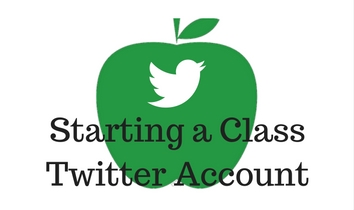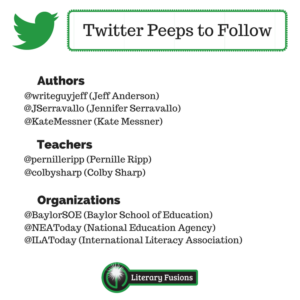 The year is off to a great start! You and your students are settled into your routines, you’re rocking the community building, and you have a month’s worth of lesson plans in the bank. Ok, maybe not the last one, but you’re probably feeling pretty confident by now and ready to try something new!
The year is off to a great start! You and your students are settled into your routines, you’re rocking the community building, and you have a month’s worth of lesson plans in the bank. Ok, maybe not the last one, but you’re probably feeling pretty confident by now and ready to try something new!
If you’ve ever thought about creating a Twitter account for your class, this is your year!
Why would you want to use Twitter in your class?
Why not! It’s an amazing way to break through the four walls of your classroom and invite the world in (in a completely manageable kind of way!). Help students learn to use social media responsibly by modeling effective use. Communicate the amazing things going on in your classroom to parents and community members. Treat it like a class portfolio where students get to post class projects and news for the world to read (observing student privacy of course, with no pictures or full names).
Get parents and extended family involved! Students are automatically more engaged when they realize that their work will be shared with an authentic audience. Twitter allows for easy dialogue between the classroom and the outside world, as Twitter users can favorite or reply to a tweet, or even directly message in response to a tweet. They could even ask a question back to continue dialogue.
 Come up with a Twitter Handle
Come up with a Twitter Handle
Your Twitter handle is like your e-mail address, it should reflect who you are! The Twitter handle you use for your class should reflect the class culture or personality. Ideally, students would be involved, if not completely in charge, of brainstorming possibilities and voting on the class favorite. As a class, talk about how the handle should reflect the class as a whole and should communicate to the world what your tweets (posts) will be about. this is critical in helping you gather followers. People often choose to follow someone based on their Twitter handle because of the kind of information they expect to come from that Twitter handle. For example, our Twitter handle is @LiteraryFusions because our passion is for literacy and how to fuse literature and reading with other subject areas, such as technology, math, social studies, and science. This is exactly what our tweets are about!
Decide on Your Purpose
Will your class be posting to share the great projects they are working on? Will your class be trying to connect to other classrooms to learn (“classroom without walls”)? Is your class trying to create awareness about a certain cause? Will they be cultivating a better relationship with family and community members? Will they be networking in the community? The possibilities are endless.
However, once the purpose has been decided upon, it’s important to stay true to that purpose and evaluate everything you post based on that purpose.
Twitter Accounts to Follow
 Start with a few strong people to follow that will be of interest to your class. You can add throughout the year as you study new topics, develop new interests, and just find new people! Remember, the information stream you’re looking to create should interest your students, not you!
Start with a few strong people to follow that will be of interest to your class. You can add throughout the year as you study new topics, develop new interests, and just find new people! Remember, the information stream you’re looking to create should interest your students, not you!
Who to follow:
- Authors! If you read a book today, odds are the author will be on twitter! Kids love being able to talk to the people who wrote their books! And authors love to connect with their fans.
- Classroom Teachers. Learn from other educators and get some idea for your own Twitter account too!
- Organizations – Museums, universities, special interest organizations – these places have a wealth of information to share!
Click on the image or this link to download a linked copy of the image: Twitter Peeps PDF
Hashtags
The best thing we can tell you here is that less is more. Use strategic hashtags to get your post out to various communities on Twitter. Think of hashtags as categories. When someone searches for that hashtag, your post will be collected in with other posts that have included that hashtag in their post.Depending on your purpose, you probably want to use already-established hashtags that people will know to search for. Consequently, this might take some research to what kinds of hashtags people are using. Here is a list to get you going:
-
#EngChat English Chat
-
#TitleTalk Title Talk (all about books!)
-
#EdChat Education Chat
-
#GAFE Google Apps for Education
-
#EdTech Educational Technology
-
#InquiryEd Inquiry Education
-
#TXEd Texas Education
-
#TXEduChat Texas Education Chat
-
#EdCamp Education Camp
-
#RWWorkshop Readers Writers Workshop
-
#LitChat Literature Chat
-
#ScienceEd Science Education
You can (and should!) also start your own class hashtag. Others can contribute to the stream of information associated with it by posting pictures from field trips or school events, and it’s an easy way to get everything all in one place.
For more on hashtags, check out Sherry’s article here: #Hashtags in the Classroom
Incorporating Twitter into your Class Routine
This will be up to you and your class. You might choose to have a specific helper designated to take pictures with a tablet or mobile device and you post them later. You might have a specific day when you post things. You might have a specific time when you come together as a class to decide what to post that day or it might just be you that posts as you see great things happening. However you decide to do it, make sure you also communicate expectations and procedures to your students around social media, just like you would do with anything in your classroom.
Twitter Safety
Obviously, in this area, consult your district acceptable use policy, as that will be what you ultimately need to follow. Other things to consider are that photos of students should not show faces (you can use a tool like Skitch to blur their faces!). You can take great action shots of the backs of heads engaged in their work! Also be cognizant of include full student names in posts – probably not a good idea!
———-
Above all else, enjoy Twitter! Use it as a tool, as a resource, and don’t stress about it. When you start your class account, be sure to follow us (@LiteraryFusions) and we will follow you back!






Leave a Reply